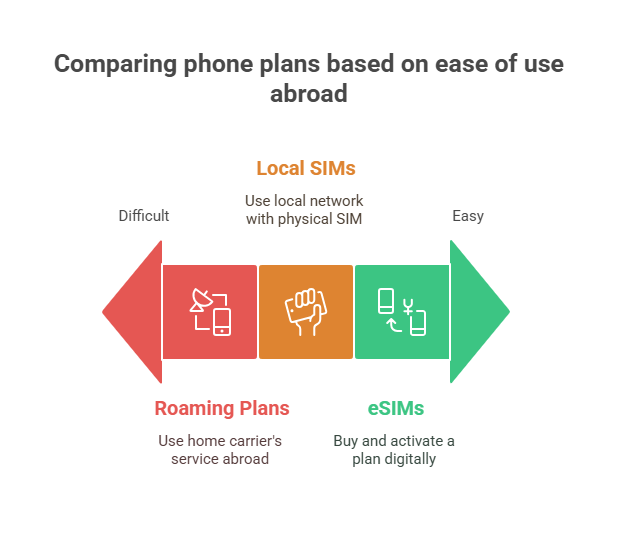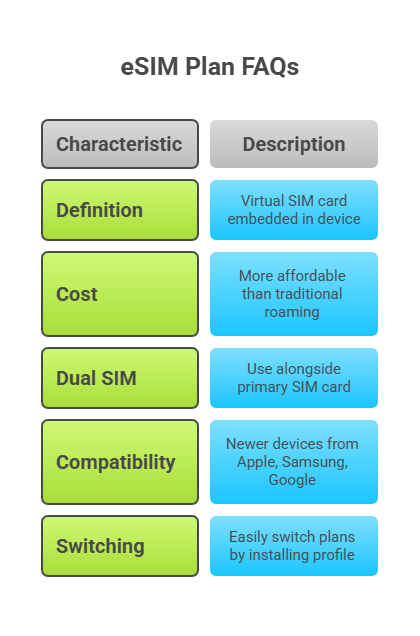This guide breaks down everything you need to know about international phone plans, comparing traditional options to modern eSIM solutions. By the end, you’ll know how to select the best plan for your needs and avoid surprise charges.
Why You Need the Right International Phone Plan
Traveling without a proper phone plan can lead to steep roaming fees or spotty coverage. Whether navigating foreign streets, joining an important video call, or updating your Instagram, reliable internet matters. A good international plan ensures you’ll remain connected without overspending.
Benefits of Modern Options Like eSIMs
- Seamless Activation: No need to swap physical SIM cards; simply activate your eSIM online or through an app.
- Global Coverage: Many eSIM providers offer plans spanning multiple countries, perfect for multi-destination trips.
- Cost Savings: Avoiding roaming fees and opting for local or regional plans can save you up to 80%.
- Environmental Benefits: No physical SIM means less plastic waste.
Example: A recent survey showed that travelers using eSIMs save an average of $100 per trip compared to traditional roaming plans.

Comparing International Phone Plan Options
1. Traditional Roaming Plans
Roaming involves using your home carrier’s service abroad. While convenient, this can result in costly surprise bills. A U.S. traveler racking up 1 GB of data abroad might pay up to $50 or more with certain carriers.
Best for: Occasional travelers or emergency use.
Downsides:
- Expensive per-MB costs.
- Limited control over data usage.
2. Local SIM Cards
These physical SIM cards allow you to use a local network in the country you’re visiting. While cheaper than roaming, they often require a trip to a store and manual setup.
Best for: Staying in one country for longer periods.
Downsides:
- Generally tied to one country.
- Hassle of buying and swapping SIM cards.
3. eSIMs
eSIMs are reshaping the game for travelers. Being “embedded” SIMs, they don’t require physical cards. You can buy and activate a plan digitally on your phone. With providers like Terminal eSIM, you can choose from a range of affordable international phone plans covering dozens of destinations.
Best for: Modern travelers who value flexibility and hassle-free setup.
Upsides:
- Supports multiple countries in one plan.
- Straightforward online activation.
- Compatible with most modern devices.

How to Set Up Your International eSIM Plan
Step 1: Check Device Compatibility
Ensure your smartphone supports eSIM technology. Most newer models (like iPhone 11 or later and Samsung Galaxy S20+) are compatible.
Step 2: Choose the Right Plan
Browse providers like Terminal eSIM to compare pricing, coverage, and data needs for your destination(s).
Step 3: Activate
- Download the eSIM’s QR code.
- Follow simple steps in your phone’s settings to install it.
- Start using your plan immediately upon arrival.
Tip: Set up your eSIM before traveling to avoid delays or relying on Wi-Fi at the airport.
FAQs About International Phone Plans
1. What is an eSIM, and how does it work?
An eSIM is a virtual SIM card embedded into your device. You activate it digitally to access mobile networks.
2. Are eSIMs cheaper than traditional roaming?
Yes! eSIMs often provide more affordable data plans and eliminate excessive roaming fees.
3. Can I use an eSIM alongside my primary SIM card?
Most smartphones support dual-SIM functionality, letting you use both your home number and an eSIM simultaneously.
4. Do all phones support eSIMs?
Not all phones are eSIM-compatible. Newer devices from Apple, Samsung, and Google typically have this feature.
5. Can I switch eSIM plans during my trip?
Yes, you can easily switch plans by installing a new eSIM profile, often within minutes.

Comparing Plans Is Easy and Affordable
Choosing the right international phone plan is crucial for staying connected and stress-free while traveling. Whether you want the convenience of eSIMs or decide to stick with traditional options, understanding your choices is the first step.
Don’t wait! Explore and compare tailored eSIM options with Terminal eSIM today. Simplify your travel connectivity and enjoy the freedom of affordable, reliable mobile plans.



